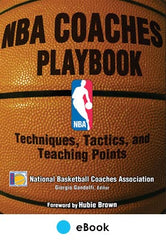Learn the seven dimensions of a sound offense
This is an excerpt from NBA Coaches Playbook eBook by National Basketball Coaches Association (NBCA).
Seven Principles of the Sound Offense
An effective offense, to my way of thinking, features the following dimensions.
- Penetration. Players must penetrate the defense, and the best way to do this is the fast break, because basketball is a full-court game, from baseline to baseline.
- Spacing. I am a fanatic about how players distribute themselves on the offensive end of the court. They must space themselves in a way that makes it most difficult to defend, trap, and help. Players must align a certain number of feet apart. In high school, I'd recommend 12 to 15 feet spacing, in college, 15 to18 feet, and in the NBA, 15 to 20 feet. Proper spacing not only exposes individual defensive players' vulnerabilities, but also ensures that every time the defense tries to trap, an offensive player will be open.
- Ball and player movements. Players must move, and must move the ball, with a purpose. Effective off-the-ball activity is much more important than most fans and players think because they're so used to watching only the movement of the ball and the player in possession of it. But there is only one ball and there are five players, meaning most players will have the ball in their hands 20 percent or less of the time the team is in possession of the ball.
- Options for the ball handler. The more options a smart player has to attack a defender, the more successful that offensive player will be. When teammates are all moving to positions to free themselves (or another teammate with a pick), the ball handler's choices are vastly increased.
- Offensive rebounding and defensive balance. On all shots we take, players must go strong for the rebound while retaining court balance and awareness to prevent the opponent's fast break.
- Versatile positioning. The offense must offer to any player the chance to fill any spot on the court, independent of the player's role. All positions should be interchangeable.
- Use individual talents. It only makes sense for an offense to allow a team to take advantage of the skill sets of its best players. This doesn't preclude the focus on team play that is emphasized in the six other principles, but it does acknowledge that some individuals have certain types and degrees of talent, and an offense should accentuate those assets. Michael Jordan taught me this.
Finally, I want the offense to flow from rebound to fast break, to quick offense, to a system of offense. The defenses in the NBA are so good because the players are so big, quick, and well coached. Add the pressure that the 24-second clock rule applies to the offense to find a good shot, and the defense gets even better.
The triangle offense has proven most effective, even against such obstacles, when players commit to and execute the system. The offense hinges on players attending to minute details in executing not just plays but also the fundamentals underlying the plays. Once players have mastered the individual techniques required of their roles, we then integrate those individuals into a team. Once this is done, the foundation for a good offense is solidly in place. The team can then go on the court with the confidence and poise so essential to success.
This method of play is as old as basketball. The triangle set is adjustable to the personnel, but such adaptations can be made without altering the essence of the offense. The only necessary adjustment from one season to the next involves tailoring the series of options based on each individual's talents.


Get the latest insights with regular newsletters, plus periodic product information and special insider offers.
JOIN NOW


